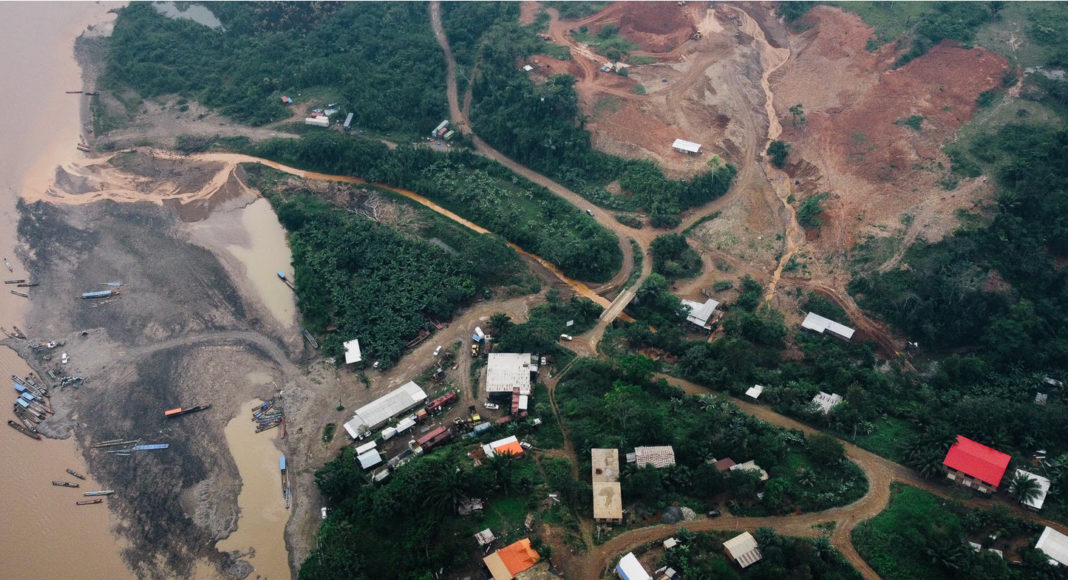This article was first published on 14 November 2022 by Los Tiempos, Bolivia. You can read the original (in Spanish) here. It was translated for LAB by Rachel Stevenson.
In the north of La Paz, Bolivia, dozens of Chinese companies operate 24 hours a day 365 days a year to extract gold. On paper they don’t exist, as they hide behind mining cooperatives that receive rent in exchange for keeping the secret. In this way, foreigners get rich with Bolivian gold without paying taxes and contaminate the rivers with mercury and other toxic waste, which later arrives at Madidi Park.
The first thing you hear when waking up is the dramatic noise of stones hitting a metal plate. It doesn’t matter that we are more than 200 metres from the operations, the racket drowns out the birdsong and the calm flow of the river.
It is still dark, 5:50 am; the engines of the dump trucks roar as they line up to collect removed sand and carry it to the top of an artificial hill. They deposit it so a digger can put it in a machine, where stones fall onto mats with thick plastic bristles and they say that, little by little, the gold is left.
The work in the mining camps in Mayaya, a community in the Amazon forest north of La Paz, never stops. Or almost never. Thousands of labourers work 11-hour shifts in gigantic areas of barren, polluted, desert-like land, which spreads like a disease. From here it poisons the Kaka River whose waters, kilometres below and together with other currents, kiss the edges of the Madidi National Park.
The miners work for Chinese business owners. An illegal association between Bolivian cooperatives and foreign investors (the majority from the Asian giant) have made this devastation a reality, with the complicity of the Bolivian state. Gold mining has destroyed nature in these populations and its impact reaches Madidi, one of the most important areas in the world for biodiversity. Every day, every hour, thousands of litres of water with mercury and other pollutants stain the rivers that flow into this protected area.
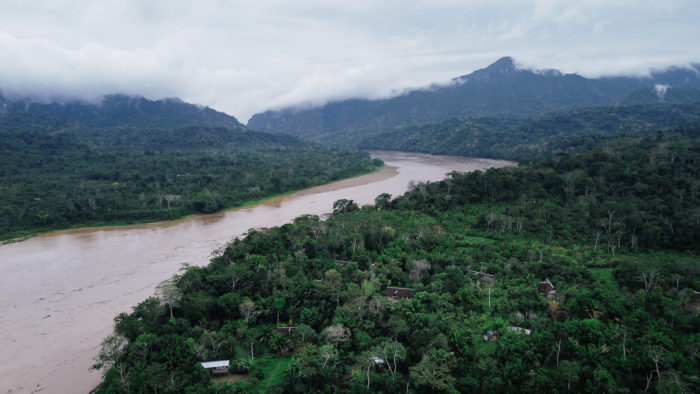
A few blocks north of the central plaza in Mayaya, crossing a reddish stream and metal containers converted into dwellings, Ernesto can be found, who has worked in mining for 12 years. He smokes a cigarette whilst he watches the work of the machine demolishing a hill in front of him. At the top some chickens have stationed themselves, who look curiously at what is happening.
‘The cooperative hired us. That’s the way it is, the cooperative gets permission from the government and they pay the land owner to work here. You make more than in the city, the lowest salary will be around Bs 3,500 ($342), others can earn up to Bs 8,000 ($783) if they operate machines.’
Ernesto is from Cochabamba and he says that Mayaya, a municipality of Teoponte, is full of Chinese foreigners, many of them undocumented. They extract kilos of gold without leaving anything in return for the communities, other than destruction.
But Bolivia owes so much money to China, so what can you tell them?
In recent years, the People’s Republic of China has turned into Bolivia’s main binational creditor. Until the end of 2021, Bolivia owed China 10.3 per cent of its public external debt, the equivalent of $1.312 million.
‘The Chinese take everything and leave nothing for the people, but the government doesn’t say anything’ a man tells us, who agreed to take us in his truck up to near the mining areas where the foreign companies operate.
He leaves us by a path that turns towards the river. After 10 minutes of walking, a desolate landscape opens up in front of us: the forest has disappeared and has been replaced by hundreds of artificial stone hills that extend as far as the eye can see. On some of them you can make out moving dump trucks and tractors in the distance.
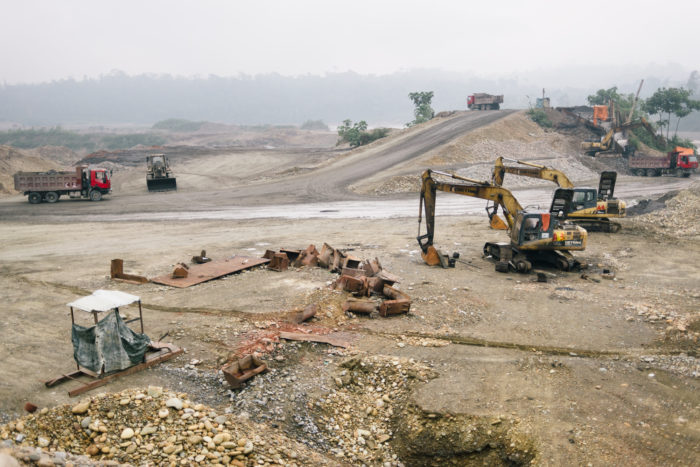
Behind us, on the same path, comes a slight man with a faded shirt, sandals and a shopping bag with a wooden tray for artisanal gold panning. He is called Marcos and he looks for some gold amongst the remnants left by the big companies. He is over 40 years old, from Cochabamba, and arrived at Mayaya just a week ago in search of better luck, since he couldn’t find work in his home district.
He tells us he recently passed through Mapiri, another mining town in the north of La Paz, 66 kilometres from Mayaya, and that there is nothing there anymore. The riverbank has turned into a grey desert of loose stones where the vultures jump in search of rubbish or a dead animal.
We walk with him up to one of the mining camps, where Luigi, an engineer who arrived from Santa Cruz a month ago to work with a Chinese company, is sitting. He has blue overalls; coca leaves gathered in his right cheek. He works in the midst of orange mud, grey stones, roaring machines and metallic and plastic debris. He speaks with his bosses through signs, since they don’t understand Spanish. When he finds out we are doing a report, he asks us:
‘Do you know if these companies pay taxes?’
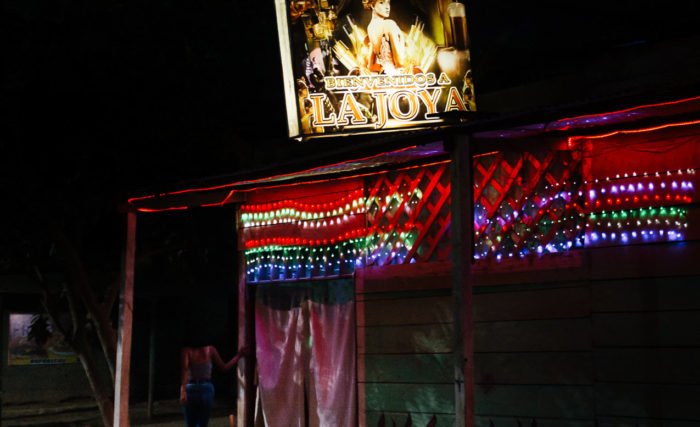
The hierarchies behind gold
We set out from Mayaya downstream in a canoe with paddles and observe how the mining operations stretch for kilometres along the Kaka River. Along the way we collide with something that seemed like a cable from some abandoned dredger, the river machines that are about 6 metres high, by 15 long and 5 wide, corroded by rust, usually inhabited and operated by Chinese citizens. By the time we saw it, about 2 metres in front of the bow, it was already too late. The canoe turned towards the right and the water started to come in. We tried to row to the bank, but it was impossible.
We capsized and watched as our belongings were swept away by the current; some were lost, others recovered, but ruined by their dunking. We had to swim to the riverbank, drenched in the murky water. We dragged the boat and emptied it of all the water inside to continue the trip, retrieving as we went the garments that were still floating.
Soaked and dejected, we paddled for a few more hours, until before nightfall. That was when we spotted, up on the right bank, a camp of diggers, the lowest rank in the mining hierarchy. They live in tents reinforced with logs tied to each other with rubber tyres, lined with blue plastic sheets, on which they put sun-dried palm leaves. Around their tents they dug shallow ditches so that if it rains, the water will run off the sides.
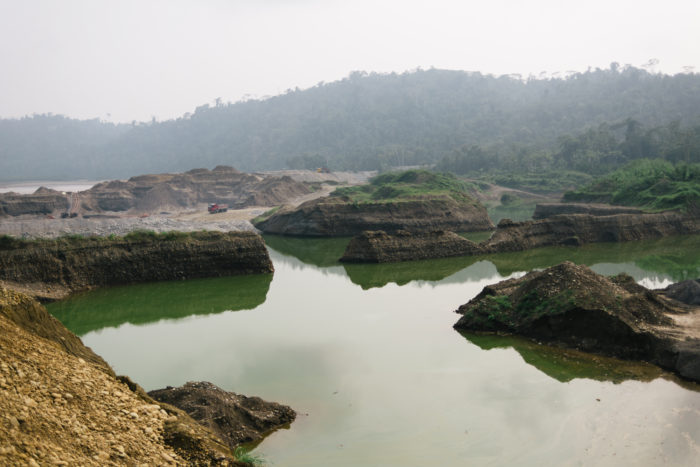
Their nickname, ‘the diggers’, comes from their activity. They labour to extract gold from the wells left by the machines when they stop their work for two hours a day, thanks to an agreement reached between the miners and the communities.
Near the beach there were only seven tents. Higher up, on an elevation 20 metres high, there were another ten of them. And between both rows of the meagre camps, a ‘neighbourhood tent’ with a television, a light bulb and two freezers that worked with a motor, since there are no electrical connections here.
The place is called Catea, a community in the municipality of Teoponte, where the gold rush is at one of its highest points. The place is registered in the name of a cooperative, according to the miners who work there; but in reality it is a Chinese company which extracts the gold relentlessly and dumps a load of toxic waste into the river. They reached an agreement with the cooperative outside the law, so both benefit: the cooperative receives between 25 per cent and 40 per cent of the profits without working or investing capital, and the Chinese company takes up to 75 per cent of the value of the gold without paying taxes. The loser is the country and the communities, who receive breadcrumbs whilst they’re stripped of their natural wealth, as has happened ever since colonial times.
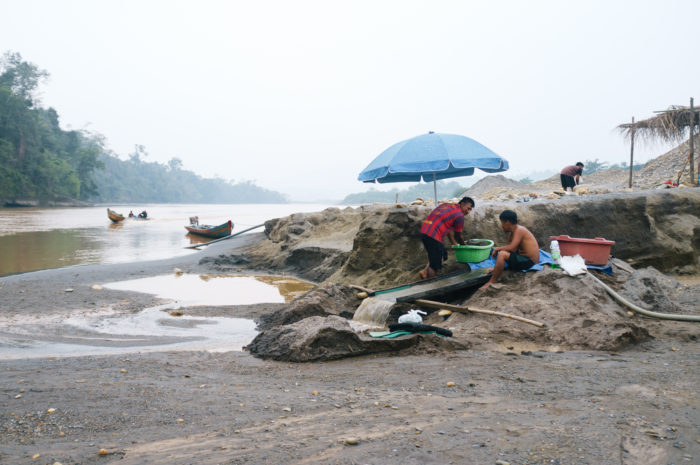
These shady arrangements have become a custom among the mining cooperatives. ‘Exactly that: there is tax evasion,’ admitted Ramiro Balmaceda, president of FECOMAN, one of the two most important federations of gold cooperatives in the world. ‘These are internal agreements outside the law’ he said when asked at a public event in the city of La Paz.
The leader justified these actions by the lack of capital investment from some cooperatives. ‘There the Chinese, Colombians and others take advantage of it’. His economic advisor, Ramiro Paredes, insisted that the government is aware of what is occurring.
Eloy Sirpa, leader of FERRECO, another of the most important federations, also admitted that the income the cooperatives receive, for camouflaging these companies, must be more than 25 per cent so that ‘there is a profit’.
Shell companies get out of paying up to 37.5 per cent of utility taxes, 13 per cent of value added tax, 3 per cent of transaction tax, and up to 7 per cent of royalties for the regions where they operate. Behind the facade of a cooperative, the regions only receive 2.5 per cent in royalties, and the State is expected to receive only 4.8 per cent in taxes in the future. This last contribution, low as it is, was allowed by the government to the cooperatives in return for their political support, but in reality it will also benefit shell companies.
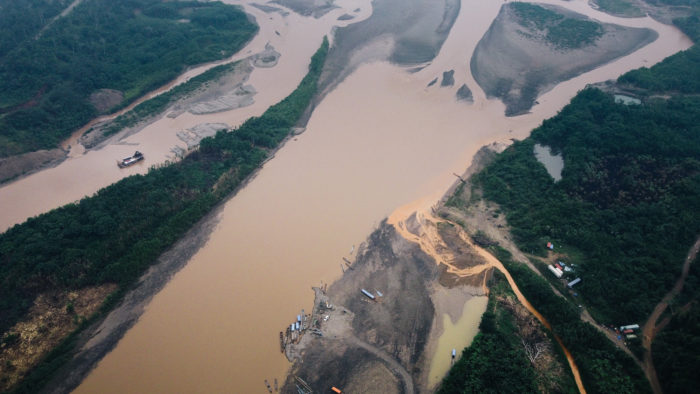
These benefits are based on ‘a policy of concession’ of natural resources, says Alfredo Zaconeta, the researcher specialising in mining issues at the Centre for Studies for Labour and Agrarian Development (CEDLA). With these advantages, ‘many choose to pose as cooperatives, others make illegal agreements and the resulting production appears to be from a cooperative and not from a company’ he adds.
According to data from the Ministry for Mining, in the first quarter of 2022, 99 per cent of gold produced in Bolivia was registered as being produced by cooperatives and only one per cent by private companies; but in reality, remarks Zaconeta, a huge and incalculable quantity of gold is extracted by private companies hidden behind cooperatives.
Tracking down these shell companies is an almost impossible task. It is suspected that their capital is linked to other illicit activities, like narcotrafficking. Different sources concerned with the issue indicate these are not registered in the country. Their transactions are made in cash, leaving no trace in the financial system, and their gold is sold on the Bolivian black market to move it abroad. The Bolivian Amazon ‘is becoming a sacrificial territory, under the false title of cooperative,’ concludes Zaconeta.
We try to find out what the Ministry for Mining and the Chinese Embassy in Bolivia have to say about these crimes and the plundering of Bolivian gold. There was no reply from the Embassy, despite various phone calls and visits to their offices in the southern zone of La Paz. The Ministry replied as follows: ‘As information about these matters does not fall within the purview of this ministry, we suggest you apply to the relevant offices to obtain it.’ However, it did not elaborate which offices it was referring to.
Extraction round-the-clock
From Mayaya to within a few kilometres of Quendeque we see Chinese mining companies everywhere, in dredgers on the river and on the riverbanks. We also see some Colombian companies.
According to official information, along the entire route from Mayaya to Rurrenabaque, there are around 146 mining zones, permits on 67 per cent of which are still being processed, so that technically they are not supposed to be operating. Only 23 per cent of the areas have mining contracts and all the requisite permits to carry out their activities. However, only in one of the 146 areas is the name of an apparently Asian company registered, which is still in the process of obtaining permission to operate. This shows that tens of Chinese companies there extract gold without any registration at all.
When night falls in Catea, the tractors and dump trucks put on their headlights so the work can continue in darkness, until sunrise, and goes on until the last gram of gold has been extracted for the foreign companies.
In the neighbourhood shop, managed by an adolescent who has his eyes fixed on the television, we share beers with two diggers and a 21-year-old man from Tarija, who was moving on to another mining camp the following day. He works as a look-out for the cooperative, making sure, from a tent set up just in front of the machine where the gold is extracted, that no one takes any nuggets. In an attempt to prevent theft, they change these guards regularly so they don’t establish any relationship with the people there.
The night passed with stories of Edson, one of the diggers. Now over 40, he started as a logger at 14, and for most of his life was a fortune seeker. He participated in never-ending parties, where he would squander the money he made from selling gold. He walked for days through the forest searching for gold deposits. He was in the Arcopongo armed conflict in La Paz in 2014, where three people died from bullet wounds and machine guns were used.
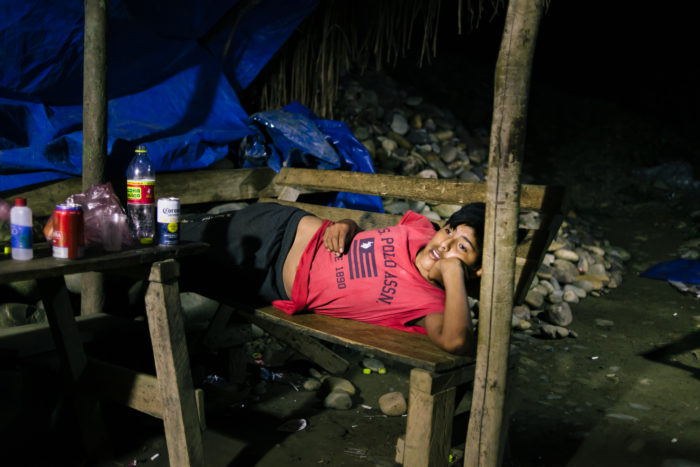
‘There I saw them killing in cold blood, one by one, people dying in front of me, then aiming at the next man and shooting him face to face’ – the digger spoke with shining eyes, plunged in images from his memory – ‘In the end the Government had to intervene. This was around eight or ten years ago’.
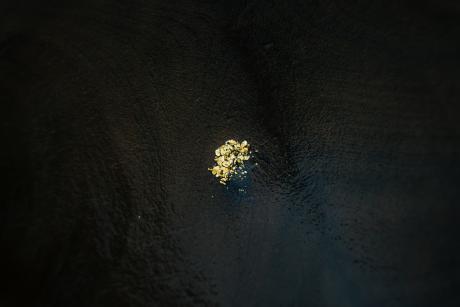
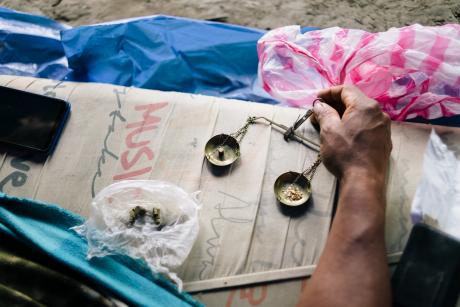
Edson’s story continued until after midnight and whilst many slept in their plastic shelters, he went in search of any grams of gold downriver. He returned before dawn and slept until almost midday, stretched out on a mattress under a tarpaulin on the riverbank. He got up after breakfast, stretched, and plodded wearily down to the stream with his wooden plate to wash the gold he had extracted in the early morning. He calculated two grams, going for more in the afternoon.
Bodies filled with mercury
In September of this year, alarming new data was published on mercury contamination in five Indigenous villages in the Beni River basin. Previous reports already showed that a population, the Esse Ejja, had levels of this toxin that were well above the limit considered ‘no risk’ by the United States Environmental Protection Agency (EPA). This limit is one part per million (ppm).
However, a new study from the Centre for Indigenous People of La Paz (CPILAP), found that members of five Indigenous villages who inhabit the Madidi have toxic levels of mercury in their bodies. In Tacanas 2.1 ppm, Uchupiamonas 2.5 ppm, Lecos 1.2 ppm, Esse Ejjas 6.9 ppm, and Tsimane-Mosetenes 2.7 ppm – all of them victims of mining contamination, mainly from fish consumption.
As seen, the Esse Ejja village is the worst affected. This is presumed to be because their diet depends mainly on fish. When visiting them in Eyoyoquibo, a community in San Buenaventura, we were able to establish the level of vulnerability and illness in which they find themselves. The elderly acquired illnesses they didn’t have before, the women have had seizures, and some children are born with physical deformities or mental problems.
Chinese imperialism present in Bolivia
The riverbanks, deforested, polluted and turned into stony ground, are filled with machines originating from China, manufactured by big companies who are mainly linked with the Chinese Communist Party (CCP). There are Howo dump trucks, from the CNHTC (China National Heavy Duty Truck Group Co.), a company of the People’s Government of China; machinery from LiuGong, a Chinese public company. The Sinotruck Group company, also part of the CNHTC, has its products distributed in these areas.
There is Detank motors, a brand linked with the Chinese company, Zoomlion, whose directors are members of the CCP.
Sany is another construction industry giant at a global level, whose products are found in Bolivian gold mines. Its president, Liang Wengen, one of the richest men in China, declared his unconditional loyalty to the CCP with declarations such as: ‘My property, even my life, belongs to the Communist Party’.
Shantui, a company managed by the Chinese Government and leader in the manufacturing of bulldozers globally, also admits to being present in these plundered spaces.
Lost somewhere in the world?
The Chinese empire is present not just in the companies and machinery that operate on dry land, but also in the dredgers floating on the river. There are around 20 in the 54 kilometres of the route from Mayaya to where it meets the La Paz River. They are rust-coloured structures that operate at almost all hours. We climbed onto one of these ships before our canoe capsized, to speak with one of them, but had no luck; they didn’t speak even a little bit of Spanish and only communicated through signing. On both sides of the dredger there were mattresses under mosquito nets where some of the crew were asleep, apparently waiting their turn to work. Only three or four were found were up and about, but when they saw us they ran off towards the kitchen, where they had gas stoves and several six-packs of Coca Cola. They watched us warily, as if expecting something bad to happen.
The only thing we could think of was to make a sign for drinking water, and they quickly lifted their lukewarm pot and filled up a bottle for us. They wouldn’t accept a single penny in exchange and waited nervously until we left in our canoe, tied up alongside their dredger.
The people there told us it is likely these foreigners are brought in from their country of origin to these remote areas, far from the big urban centres, to work from dawn to dusk, without leaving their boats. They don’t have the possibility of speaking to anyone and are disconnected from everything that happens around them, probably ignorant even of what country they have landed up in.
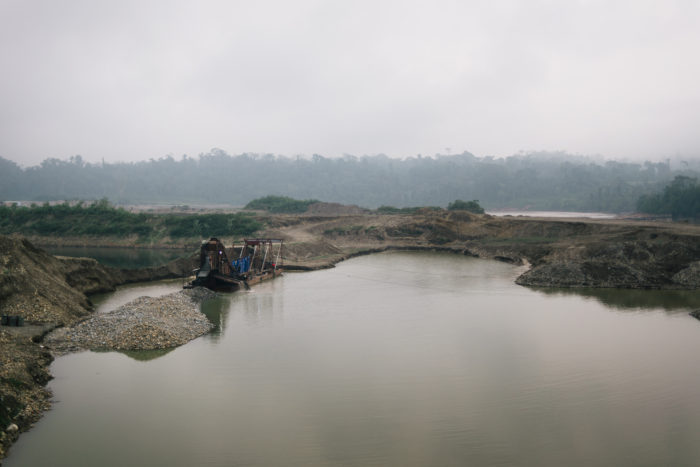
From tourism to mining
Sergio was sitting on a wooden stool under a corrugated roof supported by logs, 200 metres from the diggers’ tents, on ground stained orange and in the midst of the constant noise of the Chinese machinery operating. He arrived here three months ago to work in one of the many Chinese companies in the area. Before, he worked in tourism in Rurrenabaque, but since the coronavirus pandemic he was left with no income and had to chance his luck to support himself and pay for his youngest daughter’s studies.
When we found him, while walking through the mining camp, Sergio was talking to a young man in overalls who was fidjeting distractedly.
‘A teacher has a secure salary! Holidays, Christmas bonuses, health insurance, every month he is paid. That’s what you have to do! That’s why you have to study, so as not be screwed like we are now,’ said Sergio to the young man. ‘They pay me Bs 100 ($6.43) per day, if the owner likes my work, he gives me bonuses after a while. The Chinese are always on the lookout, keeping a close eye on you. But we work 11-hour days, in shifts, here there is no rest, it’s from Monday to Sunday, without weekends or holidays or New Years.’
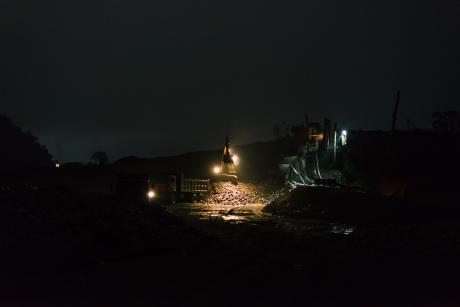
Sergio reminded us of the social strata and roles in the mining world. The mining cooperative members who appear in the papers as those responsible for the mining area can also have agreements with the actual owners of the land, to whom they pay rent. Behind them are ghost companies, the majority Chinese, although there are also Colombian and Bolivian ones. The employees are usually Bolivian, except in the dredgers, where there are more Chinese. On the bottom rung are the diggers.’
‘I wonder,’ Sergio ponders, ‘how come the Chinese just take everything? Do they leave anything behind them? Do they pay any tax?’ For his part, he hopes to return to tourism in Rurrenabaque soon.
A new world. Indigenous people are the new park rangers
‘Yes, it’s complicated going against the flow and fighting to protect what you see around you. But the worst you can do is sit by with your arms crossed’ – says Marcos Uzquiano Howard, 46, who for a year has worked to take care of the Pilón Lajas protected area, in Beni, but whose heart still remains in Madidi, the national park we are heading for, paddling our way by canoe.
Thank God the sky is cloudy, as the sun would ‘cook’ us in a few minutes. However, it is not clean clouds that cover us, but smoke from the forests that are being burned to expand pasture land for livestock and agriculture – another of the problems facing the Amazon. Marcos goes in the stern, giving instructions to paddle, and from time to time he tells us how his love affair with the park started, his battles and disappointments with the place where he has spent a good part of his life.
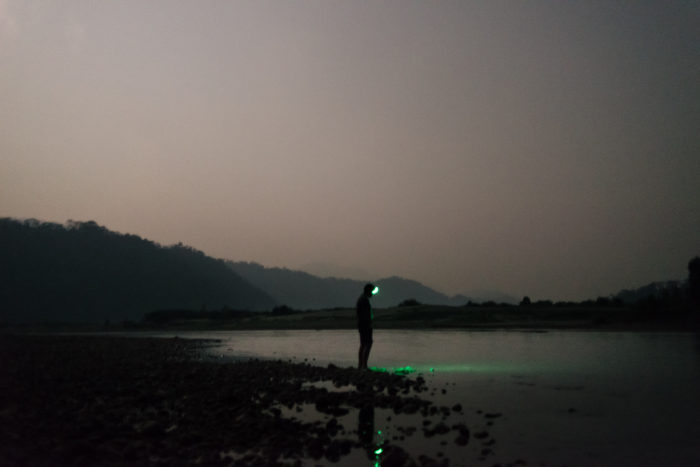
It was the turn of the century when Marcos, then 23 years old, found himself in his native land, San Buenaventura, to the north of La Paz and facing the Benian town of Rurrenabaque. He was enrolled for an Accountancy degree at the university, in the city, but it was summer and he was enjoying his holidays with his family. One sunny afternoon he was under his brother’s car, helping him repair it, when someone kicked the tyre.
‘I came out and saw a man who looked like a cowboy, with dark glasses, a wide-brimmed hat, long boots and a thick moustache. He asked me if I wanted to join the park rangers as a volunteer. I accepted immediately, even though they didn’t even pay me.’
20 years passed and Marco’s was moved from his position at the request of the gold miners. Annoyed by his constant complaints and because he was one of the few who took his work very seriously, they demanded the government get rid of him.
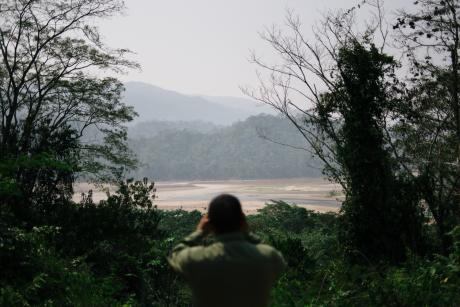
From his new position, he continues to report on the advance of mining on Madidi, which happens with the complicity of Luis Arce’s Government. But he knows that the authority of a park ranger is increasingly weak. Those who remain can no longer even count on the support of their own bosses; it is the height of irony, he insists, that these managers have allied themselves with those who practice illegal mining outside the law.
‘In these past years, mining has arrived with a vengeance,’ says a park ranger from Madidi who prefers to remain anonymous. ‘We no longer get support from the National Service for Protected Areas (SERNAP) nor the Ministry for the Environment. The actions we take against illegal mining are empty gestures and have no effect. SERNAP is an accomplice, the miners tell us to do what we have to do, because everything has already been arranged “upstairs”, anyway.’
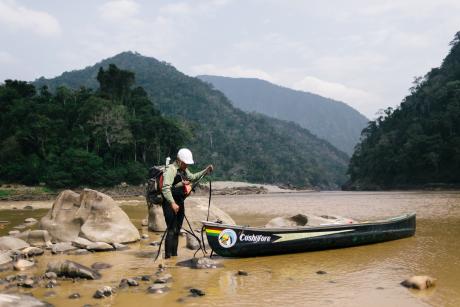
SERNAP gave assurances that to date no mining operation within Madidi had been authorised, but it was recognised that they happen outside the law without the possibility of stopping them. Different agreements between the government and the miners, which were accessed for this report, prove the alliance between both actors to enter the protected areas.
With the government in their favour, there is only one last obstacle to the miners completely invading the national park: the Indigenous communities. They have turned themselves into the new park rangers. It seems they are the only ones stopping the advance of destruction.
This has not happened on the other side of the park, in the Apolo and Pelechuco municipalities, where the gold miners cajoled the Indigenous communities, offering them wealth in exchange for nature; asphalt and concrete in exchange for gigantic forests full of life.
There, mining has prevailed and has already begun its path of death and destruction. ‘They are already inside. They are in the river and on the platforms. Here, the camouflaged companies have started to enter as well’, said the anonymous park ranger. ‘At least there, where you were, the communities are getting stronger’.
The cooperative miners know that what they do harms the environment, but they minimise the impact. Their leaders assert that they generate employment and development in the populations where they arrive with their machines and mercury. And when they are asked about their entry into protected areas, they argue that there were already people there way before the place was declared a zone where extractive activities cannot be carried out – that these communities have pre-established rights to mine.
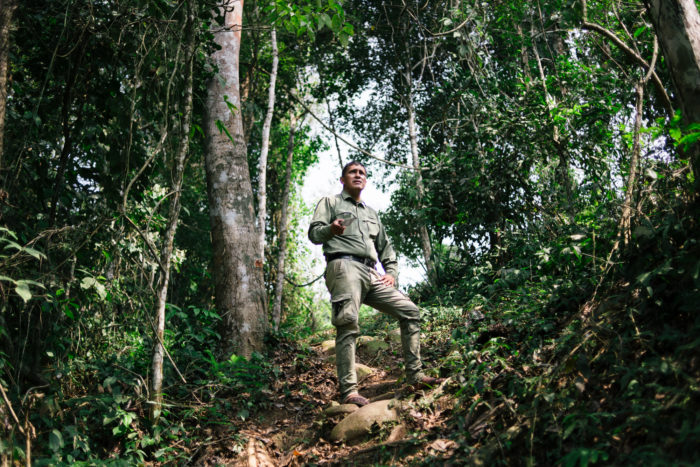
From his office chair in the centre of San Buenaventura, Mayor Luis Alberto Alipaz complained that the fight in reality is against the government, which protects and promotes this activity. ‘There is nowhere to complain because the government supports them, they issue permits, and anyone who takes it up with them ends up with bureaucracy or death’.
‘Sometimes I think it’s me who is wrong. And yes, it affects me, I could be doing other things in my free time instead of reporting what they do with the protected areas. But if I don’t do this, I wouldn’t be me anymore. In the end, this is what I am,’ explained Marcos Uzquiano.
Uzquiano spoke sat by the fire, with his eyes lost in the darkness of the jungle. We arrived at Madidi, after leaving Mayaya two days ago. We went from incessant noise, from rust and rubbish strewn on the ground to the cleanest sand we had ever seen in our lives. Surprised that there, unlike in any other place we had visited before, there was no rubbish, nor concern about there being no bins, because there were no people there.
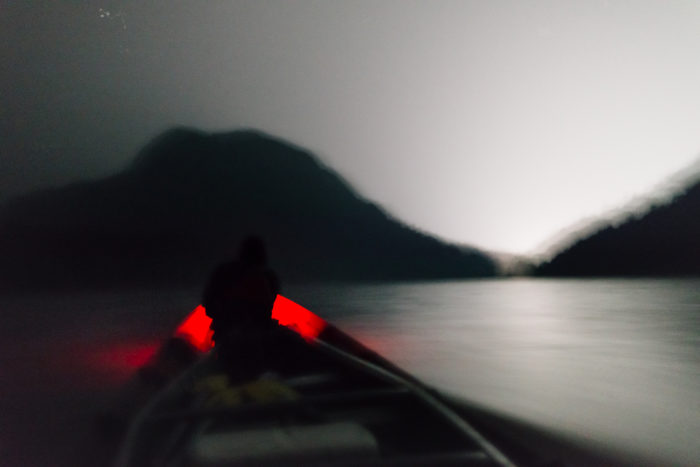
After navigating for several hours and passing twenty dredgers since leaving Mayaya, we reached a point where mechanised mining hasn’t yet arrived. It is the mouth of the Quendeque River, the most southern point of Madidi, a strictly protected area where almost no human activity is permitted. Here the water is crystal clear and the fish take shelter in this current that comes from the depths of the jungle. But the Quendeque River joins the Beni. It is a shameful junction, where transparent hope is drowned in a deluge of sickness. Thus, already contaminated, the river continues its course.
Stretched out on the sand and watching the stars through the smoke of forest clearance fires that have reached here, it seems as if we were in another world. We are near the riverbank, below an empty ranger camp. The noise of the mining has disappeared, the relentless clatter of stone against metal has vanished. The roar of engines has been replaced by the croaking of toads, by the concert of insects, by leaves that move with the wind and branches that collapse on the sand, by monkeys that howl in the distance and birds that talk amongst themselves. Silence, it is true, does not exist – the jungle has its own music.
‘How do I see the future of the park? If we go on like this, as up until now, I see it as very difficult, but I think the hope is in these new generations, where I believe there is more environmental awareness,’ says Uzquiano, while he drinks a cup of Madidi-branded coffee, which he warmed over a fire.
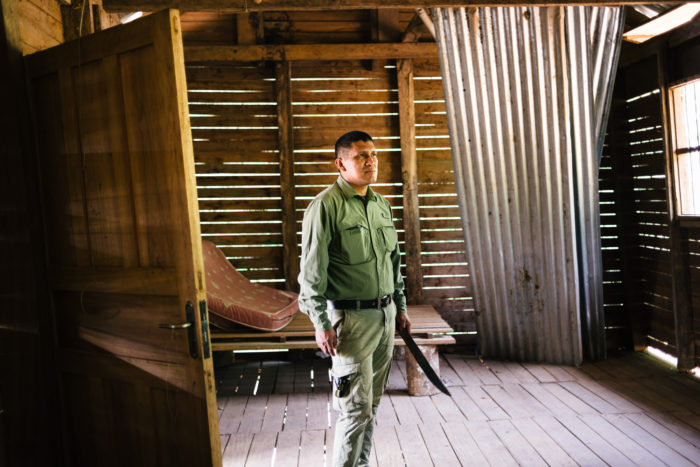
The park ranger post, located about 50 metres up the hill, is empty. There are two who usually inhabit this wooden cabin, constructed around 10 years ago. But when they start their rest days, which can last 10 days, after 20 days continuously working, the place is left empty. Some locals, finding out the guards left, enter the jungle to hunt. However, there are some who believe that the absence of the park rangers matters little since, as everyone knows, their presence is already a symbol of diminishing authority.
The wooden cabin can be found in the midst of thick vegetation. Inside are two rooms: in the first there is a bench and a round table with two hard lemons and a coconut. On a shelf there is salt, oil, a cutting blade stuck in a plastic tube that serves as a knife, and blackened bananas. The second space is a bedroom. There are two beds, or rather two wooden supports arranged on logs. On each is a dusty, ageing mattress.
The toilet is a cesspit under a metal roof set up a few steps from the cabin. Around it, there are plantain and pineapple trees for the park ranger’s supplies, and also a small, disconnected twin-burner stove can be seen. To one side, a path leads into the depths of the jungle while at the end that faces the beach, there is a log that serves as a seat to look towards the horizon, below which you can see how where Beni and Quendeque rivers join.

In the morning, before midday, we leave the crystalline waters and fine, clean sand, to continue the journey down the Beni River, skirting Madidi. The channel becomes narrow and huge boulders appear on the banks, rectangular in shape, with a dark, metallic sheen. On some of them you can glimpse the so-called Beu petroglyphs – figures of animals, plants and objects engraved on these giant rocks centuries ago, probably before the Spanish arrived in these lands. Even today it is believed that there are uncontacted villages who still live according to their ancestral customs in this region.
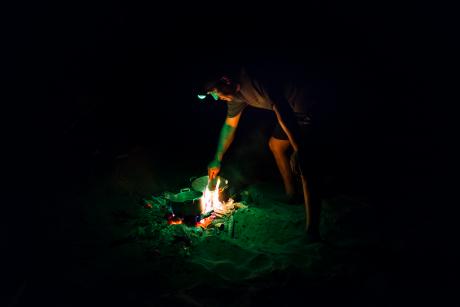
But neither the idyllic landscape, nor the mysterious rock art, nor even the rumours of semi-naked Indigenous people who move around with bows and arrows slung across their shoulders, have reactivated tourism to make it more attractive and lucrative than mining, which continues polluting the waters of these Amazon rivers. Before the pandemic, up to 6,000 tourists were recorded entering Madidi each year, according to the head of the Madidi park rangers in this region, José Luis Howard. With the quarantine and the closure of the borders there were no visitors and for this year, it is estimated that tourism will reach barely 50 per cent of what it its previous level.
‘Mining has replaced tourism in many places. In the midst of the pandemic, the miners have offered money to the people who have seen it as an opportunity to generate income’, explained Howard.
San Miguel del Bala. There are some who say that the name of this community, located in the heart of Madidi Park, comes from archangel Michael and from the peculiar shape of one of the mountains on the side of the river Beni, with the upper edge worn in the shape of a circle, as if a gigantic bullet had grazed its top.
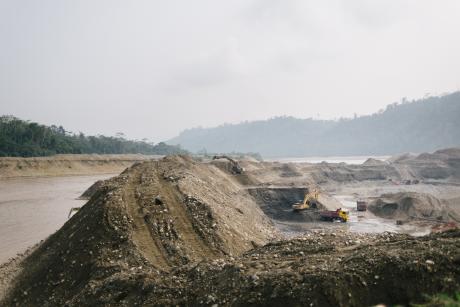
Others, like Mario Supa, a 53-year-old Indigenous guide from this place, follow an ancient story in which hundreds of Indigenous people fought each other for the gold in the tributary river. Men, women and children died, there were club blows, arrow shots, punches and, of course, gun shots.
‘This is what my grandfather told me one time when he took me fishing. I grew up with him since I was 5 and he died when I was 20,’ Mario told us.
San Miguel del Bala is a labyrinth of paths that connect houses, passes, the school and the playing field. Around Mario’s cabin, like all the others, hundreds of grapefruit lie rotting on the ground. He only has to stretch out his hand to take them from the trees. The same happens with oranges, coffee, cacao and other fruits. Before the mining boom upstream, the fish were thriving, too. ‘You could light your fire and heat the saucepan before going to fish, because in less than 15 minutes you would already have one of considerable size’, said our host, ‘Now it takes a whole day to find anything worthwhile.’
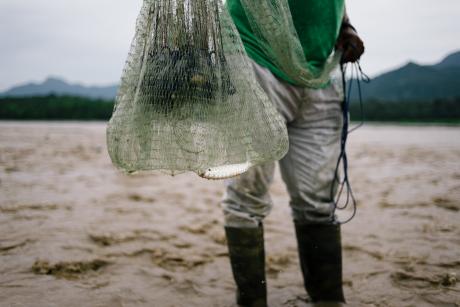
‘A few years ago, the Colombians arrived to mine. We met with other Indigenous peoples, Lecos, Tacanas, and Tsimane-Mosetenes to go and evacuate them. There were lots of us in boats. When we arrived, the people from the company told us they had permission from AJAM, but that didn’t matter to us. If they didn’t have our authorisation, they would not extract gold. We told them to go and when they saw there were many of us, they decided to leave. Afterwards the Chinese arrived with their machines. They came in ‘through the window’, you could say, but we went to drive them out anyway. The park rangers did nothing, it was just us, the people who took care of the park.’
‘Mining destroys everything you can see,’ Mario told us, gesturing to the trees, the hill, the grass that grows everywhere, everything opposite the Mayaya riverbanks. ‘Here we have everything we need: we hunt, fish, grow different crops, we also extract gold, but in an artisanal way, without using mercury. We do tourism as well, so we have plenty of options to make our living. But if they come to mine like they do in Mayaya, in Guanay, they will destroy everything. This will all be urbanised. There will be no wood, no gold, nothing. Look what happened to those people upstream. I know people from Guanay who were ruined. They make more and more money and yet they’re more worried than us, right!’
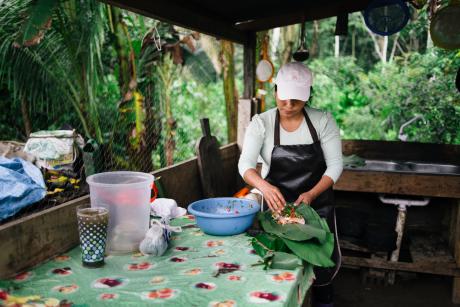
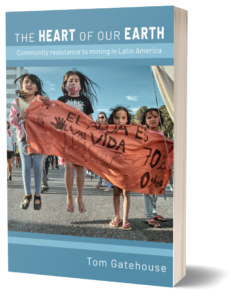
For José Luis Howard, the differences are obvious. He compares Rurrenabaque with Guanay. The first is a population devoted to tourism. The second, a village abandoned by mining. He says that in Apolo, the other entrance to Madidi, tourism was also starting to develop, until the pandemic arrived and mining became the better option for many.
‘The government contradicts itself,’ points out Mario. ‘It is a protected area and at the same time they search for oil, they mine, so what is going to be protected? There aren’t enough park rangers and now no one respects them anymore because they also work for the government and they can’t oppose them, because if they do, they will be fired. We want our children to study because in the future, if they aren’t professionals, they won’t be able to live, because here the jungle is going to be finished in around 20 years.’
Whilst these lines are being written, other Indigenous communities inside Madidi have risen up against gold mining, after the government of Luis Arce opened the way for them to enter the park with an agreement signed at the end of October 2022. It aims to regularise their operations within the protected area.
Some Indigenous groups have declared themselves guardians of Madidi and other protected areas. Their fight continues.
All photos copyright Manuel Seoane.
This report was produced with the support of Pulitzer Center Rainforest Journalism Fund.

